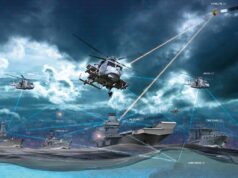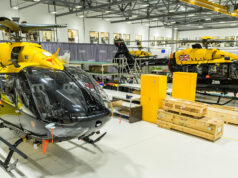British jets responded to approaching Russian bombers.
The RAF routinely identify, intercept and escort Russian aircraft that transit international airspace within proximity to the UK’s area of interest. This is routine and nothing to worry about. Quick Reaction Alert Typhoon aircraft have been scrambled to intercept Russian bombers as they approach the UK’s area of interest.
A Royal Air Force spokesperson confirmed:
“The Russian aircraft types were two Tu-95 Bear H and two Tu-142 Bear F,” the service said in a statement. Our Typhoon fighters escorted the Russian aircraft out of the UK’s area of interest. At no time did the Russian bombers enter UK sovereign airspace.”
What is the difference between the UK area of interest and UK sovereign airspace? Good question, an important question too.
Sovereign airspace is that airspace above the territory of a nation and the area of interest includes international airspace for which a country is responsible in some way, such as the provision of air traffic control services. Entering an area of interest is fine, routine and something normal. Entering national sovereign airspace is not. These aircraft are not likely to enter British sovereign airspace.
How does Quick Reaction Alert tasking work?
According to the RAF website, the National Air Defence Operations Centre (NADOC) at RAF Air Command, High Wycombe collates information from radar sites across the UK and from civilian air traffic and intelligence agencies.
“They decide the threat is sufficient to scramble Typhoon jets and pass the order to to the Control and Reporting Centres (CRCs) at RAF Scampton and RAF Boulmer. The CRCs have direct contact with the pilots at RAF Lossiemouth and pass on the scramble message. Pilots at RAF Coningsby are ordered to standby in the cockpits of their Typhoons. RAF Coningsby is the second QRA station in the UK.”
Essentially, the jets and their crews are at a moments notice to launch and intercept unresponsive or dangerous aircraft.
Why does the UK intercept aircraft outside of its own airspace?
Andy Netherwood, a former Royal Air Force pilot, explained why this is done.
“A country’s sovereign airspace extends 12 miles beyond its coastline, sitting above its territorial waters. However, there are 3 main reasons why unknown or potentially hostile aircraft must be intercepted before they reach this point.”

“The first is flight safety. Whilst sovereign airspace only extends 12 miles from the coastline, countries are responsible for ensuring the safety of civil aviation, including the provision of ATC services, within areas known as Flight Information Regions or FIRs. These extend well beyond the 12-mile limit. Russian long range aviation often transits the London and Scottish FIRs without filing a flight plan, talking to ATC or ‘squawking’ (operating their transponders). This makes them effectively invisible to civilian ATC and is very dangerous as airliners are also flying through this airspace. By shadowing Russian aircraft, the intercepting aircraft can show ATC where they are, allowing controllers to move airliners safely out of the way.
The second reason is because of the speed at which aircraft travel. An aircraft flying at 600 knots will travel 12 miles in little over a minute. Waiting until an unknown or hostile aircraft has entered sovereign airspace before intercepting is too late. It leaves insufficient time to safely carry out the intercept, visually identify the aircraft, provide all the required information back to decision-makers, and carry out any necessary action. Russian aircraft will normally be intercepted by the Norwegian Air Force and then handed over to RAF aircraft ensuring they are continually shadowed.”

“The final reason is to demonstrate capability and intent. One of the reasons Russia carries out these exercises is to test NATO and the UK. A failure to intercept would be interpreted as weakness and encourage further probing.”
For more on why the RAF intercept aircraft around the UK, you can read the full piece.
This happens often, doesn’t it?
No doubt you’ve probably noticed dozens of comments on our Facebook page saying something like, ‘nothing new’ or ‘This happens all the time it is not news!’.
While this is a common occurrence, we believe that it’s important for the public to know that. After all, if it isn’t reported frequently, how are people to know it’s a frequent occurrence and not something to worry about?













Wonder if it is that BBC Bear again?
Gotta like those Russkie Bears though D! Real airframe longevity’s and those noisy old contra rotating props are something else. I’ve been next to a Shackleton on start up/taxing out, but I’m told the Bear is way noisier .
Pity the poor crew!
Pretty awesome to see. Pity they never sent one to any of the air shows I have attended. Have they ever?
In war, turkeys if caught by fighters.
I think you’re correct D. I don’t recall them participating at Western airshows- mores the pity.
Now we know where the tv licence fees are going lol
Pmsl 👍
A strange coincidence as I was just looking at this again this morning.
When compared to a standard Eurofighter Typhoon lacking the AMK retrofit, the enhanced Typhoon’s angle of attack (AoA) was 45% greater, with faster roll rates around 100% higher.
https://tacairnet.com/2015/07/15/improving-the-typhoons-aerodynamics/
And this.
“Eurofighter has raised the possibility of a thrust-vectoring upgrade to become part of a future Typhoon mid-life upgrade, a move that could deliver substantial operational cost savings that would offset the cost involved with the engine modification.”
https://defense-update.com/20110209_typhoon_tvn.html
Rate of roll data and angle of attack is just about irrelevant when you are intercepting high level recon aircraft that won’t be doing much manoeuvring- other than flying straight and level.
Angle of attack is given in degrees and rate of roll in deg/sec when quoting aircraft performance data – to express the data as a % when you not have quoted the base line figure is meaningless.
Thrust vectoring – not required for this type of intercept.
Do you specialise in posting random /irrelevant information?
Do you specialise in being a clown Smallpiece? try looking at the bigger picture, if you’re capable of doing that?
The devils in the detail.
https://www.thedrive.com/the-war-zone/43119/latest-images-of-russias-checkmate-fighter-shows-us-just-how-big-it-really-is
https://en.wikipedia.org/wiki/Leading-edge_extension
Personally, I would add whatever we can to improve the Typhoons overall performance before we see the introduction of Checkmate and Chinas versions of the F-35, both of which will appear in large numbers.
Avionic enhancements will keep Typhoon ahead of the competition. And more powerful versions of the EJ200 are a part of the Typhoons future enhancement road map. But thrust vectoring and the aero kit looks increasingly unlikely. You’ve mentioned in previous posts the advantages radar 2 will bring, that’s the best area for investment. As a ‘rate’ fighter, Typhoon is already more than a match for any Russian or Chinese fighters. It even has performance advantages over the F22 in certain parts of the flight envelope. It recovers energy quicker for example.
The Germans are taking the aero kit, so why wouldn’t the RAF? Do the advantages come with disadvatages, or just because it’s not worth the cost?
Probably cost, and maybe not worth it. The RAF would rather spend the money on AESA Radar 2, and the new fully digital Striker 2 helmet mounted display. Both offer huge tactical advantages over any improvement in manoeuvrability. And the Typhoon isn’t lacking in performance or agility in it’s current configuration.
Off-topic, but I’m sure we could produce a more powerful land-based version of Dragonfire to protect the UK?
“Israel is to deploy a laser interception system to protect itself from ground-launched and airborne threats within the next 12 months, the government announced on 1 February.”
https://www.janes.com/defence-news/defence/latest/israel-to-deploy-protective-laser-wall-likely-iron-beam
Shooting rockets from Palestine is one thing, defending the North Sea is something else. Laser weapons simply wouldn’t have the range.
I always read you posts about aircraft with great amusement. I avoid responding because I have better things to do with my time.
However its obvious that your understanding of aircraft depends on which website you last looked at.
As I’ve said to you previously, I’ll show you my aircraft engineering qualifications, if you show me yours. I suspect yours would be a non existent document/certificate.
“I’ll show you my aircraft engineering qualifications, if you show me yours.”
How embarrassing, nothing better to do then? Keep the blinkers on.
I would suggest that before you post aircraft performance data that you understand the usual way of expressing the data and what it actually means.
Can’t help you, if your numeracy is so bad that you don’t understand that a a simple % without context is virtually meaningless.
Just like your replies then.
Here’s an additional small piece of information for you.
“The key to success in combat with all-aspect missiles is to shoot first. Supermaneuverability allows a pilot to gain a shot opportunity earlier than with conventional manoeuvrability.”
Typhoon won’t receive a mid life upgrade. It’s being continually upgraded in phase enhancements. Radar 2 and improved survivability and situational awareness would take priority over any performance enhancements. And while thurst vectoring has advantages. It also brings a weight penalty, more maintenance and a re- write of the fly-by-wire ect. And cost of course. And experience has shown Typhoon isn’t lacking in performance with 15% more thrust available from the current in service EJ200 in a war setting, but this affects engine life. And the BVR fight decides most engagements. Plus Typhoon has the superb ASRAAM and striker HMD for close in engagements. Soon to be replaced with striker 2.
Thanks for these links Nigel. I get the impression that the RAF favours walloping the other chap before they get a chance to engage. Awareness enhancements on the other hand … I wonder if the powers that be would rather put money aside for Tempest?
“I wonder if the powers that be would rather put money aside for Tempest”
Quite possibly, but what do we have to increase our current advantage over potential adversaries like Russia and China between now and the 2030’s?
The advantage of stealth is already beginning to dwindle, I wonder how useful it will be by then hence the need for RADAR 2!
https://www.thenationalnews.com/world/uk-news/2021/12/07/uk-unveils-missiles-that-can-hit-a-tennis-ball-while-flying-at-speed-of-sound/
“The ECRS Mk 2 promises to help create a Typhoon standard that enhances the RAF’s F-35 force – not merely carrying additional weapons to the fight, but bringing its own advanced capabilities that improve the F-35’s survivability and effectiveness.”
https://www.key.aero/article/depth-look-eurofighters-next-gen-radar
Many thanks Nigel for your thoughts and the links. Incidentally I can remember where I was when I first learned about stealth and wondered how long before a counter was found.
I think they call it advancements in technology!
Giving our pilots every advantage possible to me is what’s important hence the inclusion of thrust vectoring on the F-22 as an example and combined with LERX…
“Thrust vectoring control does have minimal disadvantages concerning production and maintenance costs. The increase in weight is by a small fraction of a given aircraft’s total weight, especially for large air superiority fighters. And the cost increase is also fractional.”
“The key to success in combat with all-aspect missiles is to shoot first. Supermaneuverability allows a pilot to gain a shot opportunity earlier than with conventional manoeuvrability.”
And from the perspective of an F-22 pilot.
https://www.smithsonianmag.com/air-space-magazine/how-things-work-thrust-vectoring-45338677/
Hi Barry,
“I wonder if the powers that be would rather put money aside for Tempest”
Quite possibly, but what do we have to increase our current advantage over potential adversaries like Russia and China between now and the 2030’s?
The advantage of stealth is already beginning to dwindle, I wonder how useful it will be by then hence the need for RADAR 2!
https://www.thenationalnews.com/world/uk-news/2021/12/07/uk-unveils-missiles-that-can-hit-a-tennis-ball-while-flying-at-speed-of-sound/
Worth reading in full.
“The ECRS Mk 2 promises to help create a Typhoon standard that enhances the RAF’s F-35 force – not merely carrying additional weapons to the fight, but bringing its own advanced capabilities that improve the F-35’s survivability and effectiveness.”
https://www.key.aero/article/depth-look-eurofighters-next-gen-radar
With the F35 being the silent assassin that sticks the knife in the back…..Seen this article before….😉 Worth noting, that the F35s AN/APG-81 has Radar 2 capability in service today. Short of the gimbal to give wider scan angles. APG-81 also provides electronic attack.
The aerodynamic modifications I read about the other day also. It all seemed to be advantages for knife in a phone box situation as the article I read put it. My main thought was what’s the disadvantage if there is any? Most engagements have or may have to rely on visual identification for fear of shooting the wrong person if things ever got a bit lively.
Anyway main thing was not the thrust vectoring just the aerodynamic mods. If it’s not a big job then why not.
Agreed, giving our pilots every advantage possible to me is what’s important hence the inclusion of thrust vectoring on the F-22.
Increased weight has a slight disadvantage but is minimal.
“Thrust vectoring control does have minimal disadvantages concerning production and maintenance costs. The increase in weight is by a small fraction of a given aircraft’s total weight, especially for large air superiority fighters. And the cost increase is also fractional.”
“The key to success in combat with all-aspect missiles is to shoot first. Supermaneuverability allows a pilot to gain a shot opportunity earlier than with conventional manoeuvrability.”
And from the perspective of an F-22 pilot.
https://www.smithsonianmag.com/air-space-magazine/how-things-work-thrust-vectoring-45338677/
Disadvantages are cost. Rewriting of the fly-by-wire system, and the aero mod might increase supersonic drag. And with ASRAAM and the Stiker HMD, Typhoon already holds the advantages. Speed and altitude = energy. Pilots never want to get slow because you make yourself very vulnerable. ASRAAM starts tracking target’s at BVR ranges, and displays the location of the target’s in the Pilots display as small boxes, even when the target’s are still out of visual range.Typhoon and F22 fly as high and as fast as they can to put maximum energy into the BVR AMRAAM/ Meteor shots extending the range considerably. That type of supersonic performance, and the very capable systems is what’s gives the advantages, not slow speed maneuverability, that’s just good for airshows. Typhoon is a ‘rate’ fighter, it can sustain 9g turns longer and at higher speeds than pretty much any other fighter on the market. That kind of performance and situational awareness wins the fight, not cobras and stall spins. And none of the Typhoon partner nations and overseas customers have adopted the aero kit, so must be a good reason why.
Reading between the lines…are the Portuguese F16’s flying out of Lossie covering for Typhoons in Nevada for Red Flag or were they there for some other reason ?
The Portuguese F16s are deploying to Iceland for Nato Air Policing duties. They have been stuck at Lossie for a few days due to unfavourable weather.
Cheers
At a time when war with Russia may be iminent and politicians are threatening military deployment to eastern Europe, I thought it might be of interest to establish approximately how many RAF Typhoon aircraft would be imediately available. Using purely open source information, of course.
The RAF ordered 160 aircraft, all of which had been delivered by September 2019. As of 1 April 2020, the RAF had 139 aircraft with 101 in service, apparently 41 Tranche 1 Typhoons had been withdrawn from service.
Again dated 2020, there were 6 operational T3’s and 99 FGR4’s (including 4 with 1435 Flight at the Falklands) with two written off following accidents. From this number we can deduct 5 at Wharton under test leaving 98, less 14 airframes not noted for the last two years (probably awaiting spares from the Germans). This leaves 84.
Now, all this data was taken from government spreadsheets and other open source information. The crux of the matter is how many are available TODAY, 02 Feb 2022. This information is doubtless classified and is dependent on how many airframes are with Leonardo subject to deep maintenance/repair and the availablity of trained pilots. However, we could make an educated guess and suggest 20-25.
So, we may only have about 64-69 Typhoons available. Under the current circumstances maybe this is something that Air Chief Marshal Sir Michael Wigston and Air Marshal Andrew Turner should be looking into?
War with Russia is NOT imminent.
Which makes all you’re guessing pointless.
Russia doesn’t want to go war with NATO.
NATO doesn’t want to go to war with Russia.
🤷🏻♂️
There are a lot of cavalier remarks on this site about “war with Russia”. Were that ever to occur, both sides would put themselves on the precipice of total destruction. That is why, God willing, that will never happen.
Just because the two sides possess nuclear weapons, it doesn’t mean they will be used. Both sides would prefer a conventional war.
As soon as conventional operations start to go one way or the other … as soon as command and control systems are targeted … as soon as each sides SSNs/SSKs start to bump into the other sides “at-sea nuclear deterrent” forces … as soon as the other sides SSBN bases (eg. Faslane on the UK side) start to be targetted, the risks of nuclear escalation are real. This is why Russian doctrine does not accept a notion that a peer-on-peer conflict can stay conventional.
So if we go to war, we better be prepared for anything.
Both sides (Russia and NATO) would prefer no war at all with each other.
Because Russia is not about to attack a NATO country.
64-69 Typhoons available out of ‘101 in service’ – is that really so bad for a very complex weapons system?
I am sure the maintainers could boost that number to well over 80 quite quickly if they can get the spares.
BTW, war with Russia is not imminent – they are not about to attack a NATO country.
The RAF bought 160 Typhoons at a cost to the taxpayer of about £17 billion. The most expensive weapon system ever for the UK. Thanks to the MoD mismanaging maintenance, availability of spares, training of pilots, deciding not to upgrade the Tranche 1 fleet etc, we now have only 64-69 available – however without the latest radar. The Germans and the Spanish are already operating the T4’s
We could have kept the T1 airframes in service for “aggressor” training instead of the Hawks. Now, we have neither. Absolutely shameful.
Interesting that the BBC read out the RAF release at the end of PMQ on the BBC News Channel.
Does anyone happen to know the number of typhoon pilots in the RAF currently.
On the day Johnson is meant to be calling Putin. These things don’t happen by accident, especially when it’s the Russians. First a live fire naval exercise in the western approaches and now (reportedly) 3 nuclear capable Backfire bombers off Scotland. I think we get the message…
Bears and Blackjacks are now a semi regular visitorin our neck of the woods and have been for several years. That is why Saxa Vord was reactivated.
Hi Rob, now 4 it appears.
Typhoon fighter jets have “intercepted and escorted” four Russian Bear aircraft “out of the UK’s area of interest”, the RAF has said.
https://news.sky.com/story/raf-jets-scrambled-to-track-unidentified-aircraft-north-of-scotland-12531063
Rob mentioned Backfires so this could be a different group.
I ssuspect that we will see lots more of this whilst the Russian exercise is underway off Ireland. Lots of TU-95/22M/142 and 160 photo opportunities coming up along with acres of the Daily Mail.
Hope they are well stocked with fuel at Brize as the Voyagers will be in high demand.
Dont worry about Brize, they have enough fuel to last quite some time., underground bunkers and a direct line to the refineries.
Not just Brize, most RAF stations with an airfield.
And It would seem that a certain Political Party “in Government (Allegedly)” Scotland would seem to be hoping for Independence By Further Referendum in coming years and, consequently, expulsion of Senior Service and the Royal Navy Submarines HMNB Clyde:
Potentially Dangerous Course of Action, It would seem, For Future of Royal Navy and Construction of Replacements for the Surface Fleets at Govan and Scotstoun, Given that these Shipbuilding Processes depend upon Skilled Workers Subject to Security Vetting Before and During their employment on behalf of the White Duster and the Admiralty, It would seem.
Perhaps “ever so slightly” Off Topic for the Quick Reaction Force (RAF) but, Directly Relevant to the North and Southern Approaches to the Firth of Clyde and HMNB Clyde Access at All States of the Tides in the Firth for Fleets Movements in Safety and Other Relevant Purposes, It would seem
Does the UK not return the favour? If the Russians are constantly needing escorted and causing civilian traffic to relocate, why isn’t the UK doing the same to them?
What long range bombers do we have that could do the same?
Other than basing fighters in a neighboring country such as Finland or Estonia to make incursions into Russian areas of interest we dont really have this capability that Russia has.
Rivet Joint. Operates on the periphery of Russia and the Soviet Union before that.
The Russians do send up fighters.
As for civil traffic, not many flights operating where the Rivets might be compared to the trans Atlantic air corridors!
Yeah true but a slight difference to nuclear capable bombers flying towards you than an intelligence aircraft!
Granted! But the end result, messing with their version of QRA, still applies.
Flies in the ointment whatever the type.
Would the RAF use the joint rivet to test russian QRA responses or would the Russian’s just dismiss it as its not an aircraft that would cause physical harm?
Routine?…very much so.
4x Bears?..not routine.
Putins’ subtle message to the UK regarding the NLAWS and visit to Ukraine I’m guessing.
Going to be an interesting few days off Ireland I suspect.
Up again today it seems.